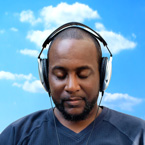Home > Listening Therapy > Well Being

The inaudible sound that one strives for in the final stage of a Raga yoga is no more than that produced by filtering of bone conduction…Dr. A Tomatis
Wellbeing and Meditation
A primary function of the ear is to convert sound waves into electrochemical impulses that charge the neocortex of the brain. This means that the quality of our listening has an impact on more than our language and communication skills. By accurately decoding sound with clarity and to our maximum potential, a new ease of communicating relays into self-confidence and improved social skills. Life is enhanced because of heightened perception and confident responses; and actual increased ability in so many aspects of daily living!
Heightened Awareness
Many clients report that Tomatis has given them heightened awareness – something akin to a state of meditation. Colours are perceived more vividly, sounds are richer, spatial awareness is more intense with clients really understanding what it means to perceive in 3 dimensions. Textures and forms seem to take on a new life and plasticity. It goes without saying that musical appreciation and ability are enlivened.
Breathing Difficulties / Constricted Throat
We have all been told that we need to breathe deeply and relax our throat, but when listening patterns are tangled, this is easier said than done. Indeed it can be partially achieved through much effort – and sometimes unfortunately, not at all. High, panicky breathing and an inability to make a strong sound are linked to a number of health problems. The ear drums are in very close proximity to the 10th cranial nerve, which is also known as the vagus nerve. Part of the function of the vagus nerve is to regulate the larynx, the pharynx and the viscera. The viscera means the heart, lungs, stomach, kidneys, liver, intestine are also all affected by the state of this nerve. In short, the better the state of the nerve, the better the state of our general health. The reason for this is that training with the electronic ear brings the tympanic membrane (our ear drum) to a state of enhanced tension; and when it is thus tensed, it attenuates, or moderates the sound impulses striking the vagus nerve. Un-attenuated and uncontrolled sounds will conversely shock and stress the vagus nerve with ill-defined content. This is like having a noisy, blurred party atmosphere, even in what should be a restful situation. By improving our perception and allowing our auditory apparatus to function more freely and regularly, we help reduce our stress levels and breathe more deeply with less effort. As one client has said, “I have practiced yoga for twenty years, but have never achieved such deep and effortless breath control.”
Insomnia
Naturally, our sleep may also be improved. Many clients report that their sleep has improved after doing the course. Even those who have been regular insomniacs have reported great improvement. I believe that this is due, to the improved functioning of the vagus nerve.
Posture
Many clients are surprised that their posture has improved. They tell me that they feel that their movements are more fluid and their gait more “self-propelled”. Others report that their backache has even disappeared overnight!
This is partly due again to the vagus nerve as it controls several of the muscles in our neck and spine. You can tell yourself to straighten up a thousand times but it is the correct tautness of the eardrum that will enable the classic “posture of the Buddha listening to the universe” naturally. Alongside this the effects of the 8th cranial nerve, also known as the vestibular nerve is present at every level of the spinal column by its junctions with the anterior roots of the medulla. The primary function of the vestibular apparatus is the integration of rhythm – which of course means movement and co-ordination – our sense of spatial awareness. People are able to control their motor functions more exactly, particularly the upper limbs. Attention musicians and sportspeople!
For more information or to book an assessment Contact us.
